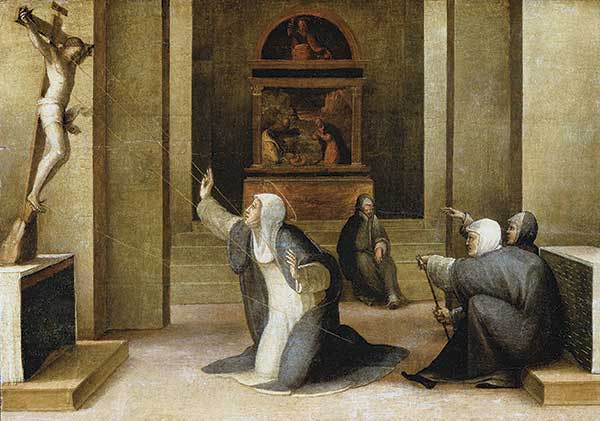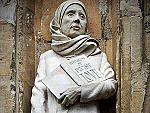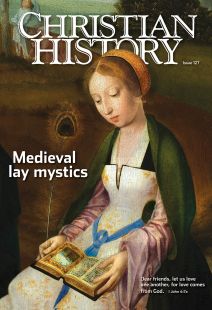The agony and the ecstasy

[One favorite subject for painters was Catherine’s story of receiving the stigmata (imprints corresponding to Jesus’s wounds).]
“Let him kiss me with the kisses of his mouth.” (Song of Sol. 1:2) Many moderns view the Song of Songs as a suggestive love poem inappropriate for mixed company. But medieval Christians would not have blushed at its explicit references. Many twelfth-century mystics read it as a grand allegory depicting the spiritual romance between God and the Christian monastic soul.
These mystics stripped the sensual language of passages such as 1:2 of any physical sensuality—for physical senses could not be trusted, nor could they lead the spiritual soul to the spiritual, divine God. The passages became metaphors to describe the path toward spiritual union with God. Although by the grace of God one might experience a glimpse or a foretaste of divine presence and even divine union in this life, the true fruition and ultimate enjoyment of God in spiritual unity was wholly otherworldly and held for the next life.
taking it to the streets
Taking this a step further, Catherine of Siena (1347–1380) and other mystics of the fourteenth century transformed these spiritualized senses and sensual language into physical manifestations in their spiritual practice. The Neo-Platonic worldview that permeated twelfth-century Christian thought (see “Like and unlike God,” pp. 14–16) was, in the thirteenth and fourteenth centuries, being challenged by, and synthesized with, a renaissance of Aristotle. His metaphysics convinced Christians that physical realities and physical experiences—ecstasy and agony—also illuminate the pathway to God.
Christ’s Passion, the physical agony that Jesus experienced along the via dolorosa, or “way of suffering,” culminating in the Crucifixion, became the new centerpiece for late medieval Christian devotion.
Even artwork reflected this shift as the crucifix evolved into a bloody carcass hanging in anguish from the cross. As the physical suffering of Jesus came to the fore of spirituality, so too did the idea that the physical suffering of the Christian mystic would lead to union with the suffering God.
Catherine of Siena (born Caterina di Giacomo di Benincasa in Siena) grew up in a tumultuous Italy and in an equally tumultuous church. The Italian city-states were battling over influence, territory, and control of the papacy. The shocking aftermath of the Black Death still lingered, and the devastation remained palpable.
In 1309 the papacy moved from its historical seat in Rome to Avignon, France, where it remained until 1377. Petrarch, an Italian poet and catalyst of the Renaissance, later described the period as “the Babylonian Captivity.” The name stuck.
Much demanded young Catherine’s attention and devotion: the turmoil in her beloved Italy characterized by conflict between the city-state of Florence and the Avignon popes; the needs of the poor, sick, and suffering; and her longing to unite with God in spiritual love. Consequently Catherine became a member of the Third Order of Saint Dominic from age 18 until her death only 15 years later at age 33.
Third orders, which still exist, are Christian laity—men and women—associated with an established religious order such as Dominicans, Franciscans, or Augustinians. They are distinguished from the “first order” (monks or friars) and the “second order” (nuns) who usually live in community and are bound by life-long vows. Members of third orders are often laypeople, do not take lifelong vows, may be married, and may or may not wear some aspect of distinctive religious dress.
The Third Order of Saint Dominic originated in the thirteenth century; by Catherine’s day it was widely recognized in Italy where the Dominicans, known as the Order of Preachers, enjoyed extensive influence. This included Siena, where Catherine’s family lived near the Church of San Domenico, an important center of Dominican education and work.
Because of her frequent visits to the church as a child, Dominican formation came at an early age to Catherine. Her first confessor and spiritual mentor, Tomaso della Fonte, was a Dominican friar.
Equally influential on Catherine’s sense of spiritual life and Christian charity were women of Siena called Mantellate. These women were members of the Third Order of Saint Dominic, and their work involved serving the needs of the poor and sick in the city. Although they did not live in community together (they appear to have been widows), they wore a monastic habit and followed the guidance of a prioress.
Catherine joined these women and their work, taking the habit herself in 1365. Although remaining in her family’s home, Catherine spent most of her time in silence and solitude, only venturing out from her self-imposed cloister for Mass at San Domenico.
keeping the pope on track
As a member of the Third Order of Saint Dominic, Catherine was taught to read and write. In her third year of religious life, according to the Life of St. Catherine of Siena (1395), she had a vision in which Jesus declared, “I marry you to me in faith.”
After this mystical marriage to Christ, she felt called to leave her homebound physical cloister to serve the world actively while remaining contemplative in what she called her interior “cell of self-knowledge.”
Unapologetically Catherine combined a contemplative life of prayer and meditation with an active life of service and care for the poor and suffering. Her wedding of these two traditional vocations of religious life proved compelling to her contemporaries, and other men and women rushed to join her.
Catherine’s work also brought her into the center of religious and political issues of her time, the most pressing of which was the papacy’s location in Avignon since 1309 and the conflict this caused with Italian city-states. Her influence on Pope Gregory XI (1370–1378) in no small way resulted in the papacy’s return to Rome in 1377.
Writing nearly 400 letters, 26 prayers, and her magnificent work, The Dialogue (c. 1378), Catherine herself provided source material for her life, personality, and spiritual path to God. These works in Italian—some dictated, others written by her—demonstrated her devotion to divine truth and an unwavering desire for mystical union with God.
Raymond of Capua, her first biographer as well as her third Dominican confessor-mentor, described the composition of the Dialogue:
Thus about two years before her death, such a clarity of truth was revealed to her from heaven that Catherine was constrained to spread it abroad by means of writing. . . .
Thus in a short time was composed a certain book that contains a dialogue between a soul who asks the Lord four questions, and the Lord himself who replies to the soul, enlightening her with many useful truths.
Called The Dialogue or The Dialogue of Divine Providence, this work is Catherine’s mystical masterpiece, which, through spiritual insight and experience, teaches the reader of love, suffering, desire, and union with God.
Earlier male mystics had more than once written commentaries on the biblical Song of Songs, explicating the spiritual meaning of the allegorical bride and bridegroom. Catherine boldly wrote her own Song of Songs, her own dialogue of personal, sensual, spiritual romance between God and her own soul.
She put into the mouth of God the statement: “The soul cannot live without love. She always wants to love something because love is the stuff she is made of, and through love I created her.”
“aflame with love”
Catherine also picked up on other common themes of medieval Christian spirituality. One, the idea that thirsting for self-knowledge ultimately leads to knowing God, runs through Catherine’s Dialogue as it had other mystical works.
Christian mystics, informed especially by Augustine, understood the “image of God” (Genesis 1:26) to be impressed on the human soul. Therefore true self-knowledge through contemplation of one’s own soul could lead to knowledge of God. One must be cautious, however, and not confuse the image with the object—the human soul is not God but has the image of God (see “Like and unlike God,” pp. 14–16).
But as with viewing God in a mirror, self-knowledge leads one to greater understanding of and connection with the true object of that image: God. Catherine wrote in the Dialogue in the voice of God:
But [the soul] grows and exercises herself in the light of self-knowledge. . . . From this she draws a bit of knowledge of my goodness, aflame with love, and she begins to conform her will with mine.
Mystics were also much concerned with understanding how loving God leads to God. Reflecting on passages like I John 4:8 and Romans 5:5, many have written that since God is love, one comes to know and experience God by loving God.
For the Christian mystic, we reciprocate the love of God for us with the very love God has given us to love God in return. Expressing this in her own words, attributed to God in the Dialogue, Catherine wrote:
See, then, with what affectionate love you ought to love and desire both the gift and the giver. If you do, your love will be pure and genuine and not mercenary. This is how it is with those who keep themselves always enclosed in the house of self-knowledge.
“endure courageously”
For late medieval mystics, suffering also played a central role in the path toward God. Just as God suffered in the crucified Christ, so the human person can come to know and understand God through suffering “in spirit or in body.” Catherine has God explain in one place in the Dialogue,
Because those who have such sorrow have infinite desire and are one with me in loving affection . . . every suffering they bear from any source at all, in spirit or in body, is of infinite worth.
In another place she writes, again speaking on behalf of God,
For I have already told you that suffering and sorrow increase in proportion to love: when love grows, so does sorrow. . . . Patience is not proved except in suffering, and patience is one with love, as has been said. Endure courageously then.
Here Catherine connected the mystic’s suffering with divine love, which for her was most profoundly expressed by God in the Crucifixion of Christ. Love, suffering, desire—each of which is mutual between the soul and God—formed the foundation for Catherine’s path toward God and hope for spiritual union with him.
Through daily meditative devotional practice and continual prayer, Catherine believed that the soul’s love, suffering, and desire reach and connect with God. She wrote, “This is why I told you that holy desire, that is, having a good and holy will, is continual prayer.”
Catherine closed her Dialogue describing, in her own words, that which all mystics seek—God’s gracious response in fulfillment of the soul’s longing:
You responded Lord; you yourself have given and you yourself answered and satisfied me by flooding me with a gracious light so that with that light I may return thanks to you.
Clothe, clothe me with yourself, eternal truth, so that I may run the course of this mortal life in true obedience and in the light of most holy faith. With that light I sense my soul once again becoming drunk! Thanks be to God. Amen.
contemplative but active
Catherine, only 33 when she died of a massive stroke, became one of the most extraordinary women of the Middle Ages. Her participation in male-dominated politics and religious conflict, her unrelenting work with the poor and suffering in her local community, and, most notably, the depth of her own writings and their subsequent centuries of influence on Christian devotion assure her place in history.
Though a laywoman without formal education in a tertiary order, she parallels in striking ways the most famous mystic of the twelfth century, Bernard of Clairvaux (see “The fires of love,” pp. 37–41). Both Catherine and Bernard dynamically combined contemplative and active life; greatly influenced religious and political issues of their day; and encountered God in profound mystical experience. That experience together with their ascetic discipline resulted in writings that have inspired and nourished countless spiritual seekers over many centuries from their day to ours. CH
By F. Tyler Sergent
[Christian History originally published this article in Christian History Issue #127 in 2018]
F. Tyler Sergent is assistant professor of history at Berea College in Berea, Kentucky.Next articles
A medieval mystic untimely born?
In Brother Lawrence the desires that had motivated medieval mystics found fresh expression.
Kathleen MulhernThe fires of love
From the highest nobility to the lowest working class, medievals heard the call of God over four centuries.
Matt ForsterMedieval mystics: Recommended resources
Here are some recommendations from CH editorial staff and this issue’s authors to help you understand medieval mystics and their world.
The issues authors and editorsSupport us
Christian History Institute (CHI) is a non-profit Pennsylvania corporation founded in 1982. Your donations support the continuation of this ministry
Donate






